First Tennessee Park
 | |
|
First Tennessee Park at dusk | |
| Location |
19 Junior Gilliam Way[1] Nashville, Tennessee United States |
|---|---|
| Coordinates | 36°10′23″N 86°47′06″W / 36.173031°N 86.785033°WCoordinates: 36°10′23″N 86°47′06″W / 36.173031°N 86.785033°W |
| Owner | Metropolitan Government of Nashville and Davidson County |
| Operator | Nashville Sounds Baseball Club |
| Capacity |
8,500 (fixed seating)[2] 10,000 (plus berm seating)[2] |
| Record attendance | 11,759 (July 3, 2016; Nashville Sounds vs. Oklahoma City Dodgers)[3] |
| Field size |
Left Field: 330 feet (100 m) Left-Center Field: 386 feet (118 m) Center Field: 403 feet (123 m) Right-Center Field: 388 feet (118 m) Right Field: 310 feet (94 m)[4] |
| Acreage | 10.8 acres (4.4 ha)[4] |
| Surface | Bermuda Tifway 419 grass[4] |
| Construction | |
| Broke ground | January 27, 2014[5] |
| Opened | April 17, 2015[6] |
| Construction cost |
$47 million[7] ($47 million in 2016 dollars[8]) |
| Architect |
Populous[2] Hastings Architecture Associates, LLC[2] |
| Project manager |
Gobbell Hays Partners, Inc.[2] Capital Project Solutions, Inc.[2] |
| Structural engineer | Walter P. Moore[2] |
| Services engineer | Smith Seckman Reid, Inc.[2] |
| General contractor | Barton Malow/Bell/Harmony, A Joint Venture, LLC[2] |
| Tenants | |
| Nashville Sounds (PCL) (2015–present) | |
First Tennessee Park is a minor league baseball park in downtown Nashville, Tennessee. The home of the Triple-A Nashville Sounds of the Pacific Coast League (PCL), it opened on April 17, 2015, and can seat up to 10,000 people. It replaced the Sounds' former home, Herschel Greer Stadium, where the team played from its founding in 1978 until 2014.
The park was built on the site of the former Sulphur Dell, a minor league ballpark in use from 1870 to 1963. It is located between Third and Fifth Avenues on the east and west (home plate, the pitcher's mound, and second base are directly in line with Fourth Avenue to the stadium's north and south), and between Junior Gilliam Way and Harrison Street on the north and south. The Nashville skyline can be seen from the stadium to the south.
The design of the park incorporates Nashville's musical and baseball heritage and the use of imagery inspired by country music, Sulphur Dell, and Nashville's former baseball players and teams. Its most distinctive feature is its guitar-shaped scoreboard—a successor to the original guitar scoreboard at Greer Stadium. The ballpark's wide concourse wraps entirely around the stadium and provides views of the field from every location. The greenway section connects with two other greenways in the city.
Though primarily a venue for the Nashville Sounds, other collegiate and high school baseball teams based in the area, such as the Vanderbilt Commodores and Belmont Bruins, have played some games at First Tennessee Park. It is also home to the City of Hope Celebrity Softball Game. As of 2016, there are plans for the park to host concerts and other non-baseball events in the future.
History
Planning
As early as 2006, the Nashville Sounds had planned to leave Herschel Greer Stadium for a new ballpark to be called First Tennessee Field,[9] but the project was abandoned after the city, developers, and team could not come to terms on a plan to finance its construction.[10][11] Instead, Greer was repaired and upgraded to keep it close to Triple-A standards until a new stadium could be built.[12] In late 2013, talks about the construction of a new ballpark—later called First Tennessee Park—were revived.[13] Three possible sites were identified by the architectural firm Populous as being suitable for a new stadium: the east bank of the Cumberland River, the North Gulch area, and Sulphur Dell.[14] Sulphur Dell, the site of the city's original ballpark from 1870 to 1963, was chosen.[13]
Mayor Karl Dean drafted plans for financing the stadium and acquiring the necessary land from the state.[13] The deal involved the Metropolitan Government of Nashville and Davidson County (Metro) receiving the state-owned Sulphur Dell property—then in use as a parking lot for state employees—in exchange for paying the state $18 million for the construction of a 1,000-car parking garage on the site and $5 million for an underground parking garage below the proposed new state library and archives.[15] The city also acquired the property on which the Nashville School of the Arts is located.[15]
The financing plan involved public and private funding. The city paid $75 million for the acquisition of the land and construction of the stadium.[7][16][17] The stadium is owned by the city and is leased to the team for 30 years, until 2045.[15] The Sounds ownership group spent $50 million on a new, mixed-use and retail development next to the facility.[15] The construction of two apartment buildings with retail space beyond the left field wall is scheduled to be completed in early 2018.[18] North of the site, Embrey Development Corp. built a privately funded apartment complex called The Carillon.[19] The city's $75 million expenditure resulted in taking on $4.3 million in annual debt, which will be paid for by five city revenue streams: an annual $700,000 Sounds' lease payment, $650,000 in stadium-generated sales tax revenue, $750,000 in property taxes from the Sounds development, $675,000 in property taxes from the Embrey development, and $520,000 in tax increment financing.[15] The city pays $345,000 for annual maintenance of the stadium.[15]
Memphis-based bank First Tennessee purchased the naming rights to the stadium for ten years with an option for a further ten years, naming it First Tennessee Park.[20] Financial terms of the deal were not disclosed. First Tennessee's name had been attached to the team's previous attempt at building a new stadium a decade earlier.[9]
Construction
The ballpark project received the last of its necessary approbations from the Metro Council, the State Building Commission, and the Nashville Sports Authority on December 10, 2013.[21][22] Groundbreaking took place on January 27, 2014; the public ceremony was attended by Mayor Dean, Sounds owner Frank Ward, Minor League Baseball president Pat O'Conner, and Milwaukee Brewers General Manager Doug Melvin.[5] At the time, the Sounds were the Triple-A affiliate of the Brewers.[23]
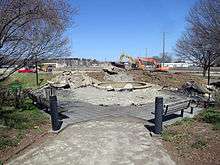
The construction team began site excavation on March 3.[22] Workers excavated artifacts dating to around 1150 AD. Fire pits and broken pieces of ceramic pans were found in the ground below what would be left field. Archaeologists believe the area was the site of a Native American settlement and that the artifacts were the remnants of a workshop where mineral water from underground sulfur-bearing springs was boiled to collect salt.[24] The artifacts are on permanent display in the Tennessee State Museum's Mississippian Period exhibit.[25]
Construction of the ballpark's steel frame began on August 18;[22] 2,435 short tons (2,209 metric tons) of steel and 16,314 cu yd (12,473 m3) of concrete were used.[22] By November 3, the installation and testing of the stadium's four free-standing light poles and two concourse-based lighting arrays had begun.[22] Installation of the 8,500 seats started on January 20, 2015.[22] The guitar-shaped scoreboard began to be installed on February 23.[22] On March 19, the home plate from Greer Stadium was transferred to First Tennessee Park, and on the same day crews began laying the sod.[22]
During construction, the need for new water and electrical supply lines arose. Because these were not factored into the original $65 million cost, another $5 million was appropriated from existing capital funds.[17] Another $5 million was later required to pay for cleaning contaminated soil, increased sub-contractor pricing, additional labor costs incurred by delays caused by snow and ice, and upgrades including the guitar-shaped scoreboard.[7] The Sounds ownership team contributed $2 million toward the cost of the scoreboard.[7] This extra $10 million brought the total construction cost of the stadium to $47 million and the total cost of the project to $75 million.[7]
First Tennessee Park received LEED silver certification by the U.S. Green Building Council in April 2015 for its level of environmental sustainability and for using strategies for responsible site development, water savings, energy efficiency, materials selection, and indoor environmental quality.[26][27] Some of the ballpark's environmentally friendly initiatives include a 2,800 sq ft (260 m2) green roof on a concessions building along right field, rainwater harvesting, and a rain garden.[6] A section of greenway beyond the outfield wall connects the Cumberland River Greenway to the Bicentennial Mall Greenway.[28] The project team also diverted or recycled 90 percent of construction waste from landfills, and almost a third of building materials were regionally sourced.[27]
Minor League Baseball
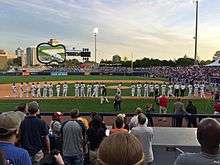
In the ballpark's inaugural game on April 17, 2015, the Sounds defeated the Colorado Springs Sky Sox, 3–2 in 10 innings, courtesy of a walk-off double hit by Max Muncy that scored Billy Burns from first base.[29] Nashville's Arnold León recorded the first strikeout at First Tennessee Park when Colorado Springs' Matt Long struck out swinging as the leadoff hitter at the top of the first inning.[29] The park's first hit was a left field single that came in the top of the second inning off the bat of Colorado Springs' Matt Clark, who played for the Sounds in 2014.[29] Clark also recorded the stadium's first RBI, slapping a single to center field in the fourth inning that sent Luis Sardiñas across the plate for the park's first run.[30] The first home run in the park's history was hit by Nashville's Joey Wendle four games later on April 21 against the Oklahoma City Dodgers.[31]
Tickets for the home opener, which went on sale March 23, sold out in approximately 15 minutes.[32] Though berm and standing-room-only tickets are normally sold only on the day of games, the team began selling these in advance of the first game due to high demand.[32] Paid attendance for the first game was a standing-room only crowd of 10,459.[29] Before the game, Mayor Dean threw out the ceremonial first pitch.[29] "The Star-Spangled Banner" was performed by Charles Esten (a star of the television series Nashville), who also sang at the park's ribbon-cutting ceremony earlier in the day.[29] Also present at the ribbon-cutting were team owners Masahiro Honzawa and Frank Ward, Pacific Coast League president Branch Rickey III, Oakland Athletics president Michael Crowley, Mayor Dean, and members of the Metro Council who voted to approve financing for the stadium.[13]
By the all-star break in mid-July, the attendance had reached 332,604, a higher attendance than in the entire 2014 season at Greer Stadium, which had totaled 323,961 people over 66 games. The 2015 season attendance finished at 565,548, for an average attendance of 7,965 per game, compared to 4,909 per game for the last season at Greer.[33] By the end of the 71-game 2015 season, 565,548 people had attended a game at First Tennessee Park—an average of 7,965 per game.[34]
For 2016, more safety netting was added behind home plate which extended the protective netting to cover the seating area behind both dugouts.[35] Other additions to the ballpark included six 14-foot-diameter (4.3 m) ceiling fans on the concourse, new drinking fountains and water bottle filling stations, the opening of a center field entrance adjacent to the new parking garage beyond right-center field, and improvements to the children's fun zone on the first base side.[36] The ballpark's record attendance was set on July 3, 2016, when 11,759 people watched the Sounds play against the Oklahoma City Dodgers on the night of the team's Independence Day celebration.[3]
Other events
First Tennessee Park began hosting the annual City of Hope Celebrity Softball Game in 2015. Started in 1990, the event is played during the CMA Music Festival held in Nashville, and was previously held at Herschel Greer Stadium from 1991 to 2014. Two teams of country music stars representing the Grand Ole Opry and iHeartRadio compete in the game with all proceeds going to fund the research and treatment of cancer, diabetes, and other life-threatening diseases. Past participants have included Carrie Underwood, Darius Rucker, Florida Georgia Line, Jason Aldean, Luke Bryan, Scotty McCreery, and Vince Gill.[37] Over $200,000 was raised from the first game held at the park.[38]
On March 29, 2016, the Vanderbilt Commodores and Belmont Bruins became the first collegiate teams to play at the facility.[39] The Commodores defeated the Bruins, 8–2, in front of a crowd of 3,782 people.[40] The park also hosted a few Reviving Baseball in Inner Cities youth games in its first season.[39] The course of the 2016 Rock 'n' Roll Nashville Marathon led runners to complete a partial lap around the concourse and a full lap around the field's warning track.[41] The first non-sports event held at First Tennessee Park was the Nashville Brew Festival, held on October 3, 2015.[39] Planned as an annual event, the inaugural festival featured over 50 breweries offering unlimited beer with paid admission. On July 16, 2016, the park hosted the first "Big Guitar Brewfest" featuring over fifty local and craft breweries, four liquor sampling tents, and food from The Band Box and concession stands.[42] There are plans for other non-sports events, including concerts, to be held at the park.[39]
Facilities
Design
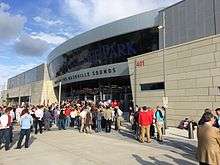
After Sulphur Dell was dismantled on April 16, 1969, the ballpark's sunken field was filled in with rock, dirt, and the remains of the demolished Andrew Jackson Hotel.[43][44] It was then converted to a number of state-owned parking lots for the nearby the Tennessee State Capitol.[6] While Sulphur Dell was nestled in an area that was home to the city's garbage dump, stockyards, the Atlantic Ice House building, and other various warehouses,[44][45] First Tennessee Park is now surrounded by new apartments, parking ramps, and restaurants.[6] The facade surrounding the home plate entrance on the stadium's north side is constructed from cast ultra-high-performance concrete planks, zinc panels, and an array of windows that stretches across the full width of the entrance.[46] To the south of the stadium, beyond the outfield wall, is an area that connects the city's Cumberland River Greenway to the Bicentennial Mall Greenway.[28] It will be open to the public on non-game days after the surrounding apartment buildings and retail spaces are completed in spring 2018.[2][18]
The grandstand has a 24-to-36 ft (7.3-to-11.0 m) wide concourse that wraps around the playing field. The field is recessed 17 ft (5.2 m) below the street-level concourse so it can be viewed from the entrances and seats.[47][48] Most of the on-field action can be viewed from the concourse; televisions showing live feeds of the game are located there. The seating bowl provides views of Nashville's skyline to the south.[6]
The ballpark was built to withstand a 100-year flood because it is located on a flood plain. Before its redevelopment, the area, including the original Sulphur Dell ballpark, was prone to regular flooding from the nearby Cumberland River and it flooded during the 2010 Tennessee floods. To prevent water damage, the grandstand has an acrylic floor covering and the field-level suites are equipped with detachable floor boards, food-service tables mounted on casters, and raised floor outlets and electrical switches.[6]
The ballpark's design is inspired by Nashville's heritage, as design elements throughout the park incorporate musical and baseball imagery to connect the park with the city's past.[46] Directional signs are accompanied by information about former Nashville players such as Al Maul, Tom Rogers, and Turkey Stearnes.[49] The park's suites include displays about Sulphur Dell, the Nashville Vols, a minor league team that played there from 1901 to 1961, and in 1963, and other past teams from Nashville. The back of the outfield wall's green metal batter's eye has a tin sign marking the former location of Sulphur Dell's marquee declaring, "Site of Sulphur Dell, Baseball's Most Historic Park, 1870–1963".[49] A series of nine vertical panels on the right field greenway provide information on the history of baseball in Nashville from the 1860s through 1963.[50] Another five panels beyond left field detail facts about the prehistory of the site.[51] Light stanchions in the grandstand and the outfield resemble the lights installed at Sulphur Dell.[6] Details including guitar pick-shaped signs and the use of red, black, and platinum silver identify the ballpark with Nashville's country music heritage and reflect the visual identity of the Nashville Sounds.[52]
Playing field and dimensions

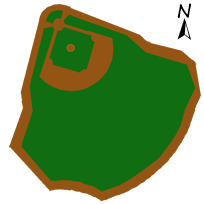
The playing surface at First Tennessee Park is covered with 100,000 sq ft (9,300 m2) of Bermuda Tifway 419 grass sod that was grown on a farm in San Antonio, Texas then over-seeded with 1,000 lb (450 kg) of perennial rye-grass.[4][53] Over 13,000 sq ft (1,200 m2) of red clay infield soil was brought in from Laceys Spring, Alabama.[13] The warning track surrounding the field is made of 21,000 sq ft (2,000 m2) of crushed red shale on top of 5,000 short tons (4,500 metric tons) of sand and 44,000 cu ft (1,200 m3) of gravel.[22] The field is equipped with a drainage system capable of draining 10 in (25 cm) of water per hour.[2]
The distance from the home plate to the outfield wall ranges from 330 ft (100 m) in left field, 403 ft (123 m) in center field, and 310 ft (94 m) in right field.[54] First Tennessee Park's right field wall was moved to this shorter-than-normal distance to pay homage to Sulphur Dell's short right field fence that measured 262 ft (80 m).[55][56] The backstop is approximately 50 ft (15 m) behind the home plate.[47] The field is set 17 ft (5.2 m) below the street-level concourse.[47]
The dugouts, which measure 88 ft (27 m) by 16 ft (4.9 m), are large enough to accommodate each team's staff without the need for relief pitchers to sit in the bullpens.[13] The Sounds' dugout is located on the third-base side; the visiting team's is located on the first-base side.[13] Bullpens are located in foul territory along the left-field and right-field lines near the corner of the outfield wall.[13] The home clubhouse has wooden lockers, two couches, three card tables, and a center table.[57] There is an attached kitchen with two full-size refrigerators and room for hot and cold catering.[57] Other player amenities include large, indoor batting cages, a fully equipped workout room, and a family room for players' partners and children.[6][57] In 2016, the umpire dressing room was named after former Major League Baseball umpire and Nashville native Chuck Meriwether.[58]
In its first season, First Tennessee Park developed a reputation as a pitcher's park. In 2015, its park factors were significantly lower than those at other ballparks in the Pacific Coast League (PCL) and across Triple-A baseball. The park had the lowest run and home-run factors of all 30 Triple-A teams, and its hits factor was the fifth-lowest in Triple-A and the fourth-lowest in the PCL.[59] In 2016, the park had the lowest home-run factors in Triple-A, its runs factor was the sixth-lowest in Triple-A and fifth-lowest in the PCL, and its hits factor was the seventh-lowest in Triple-A and the sixth-lowest in the PCL.[60]
Scoreboard
One of Greer Stadium's most distinctive features was its guitar-shaped scoreboard.[61] After First Tennessee Park was approved, the team announced it would not be relocating the original Greer scoreboard, which was technologically outdated and difficult to maintain, to the new stadium.[62] While plans for First Tennessee Park's scoreboard were initially undisclosed, following overwhelming support for Greer's guitar from the community, the team announced plans for a larger, more modern guitar-shaped scoreboard for the new ballpark.[62] The new guitar scoreboard, paid for entirely by the Sounds, was designed by TS Sports in conjunction with Panasonic, and was installed beyond the right-center field wall on the concourse.[54][63]
The scoreboard, which has a 4,200 square foot (390 m2) high definition LED screen, is located in the middle of the concourse; visitors entering or leaving the park through the stadium's right-field entrance on Fifth Avenue pass under it.[63] Excluding the neck and the borders of the body and headstock, the surface of the guitar is composed of LED screens. Overall, the guitar measures 142 by 55 ft (43 by 17 m),[46] its body display is 50.4 by 66.14 ft (15.36 by 20.16 m), the headstock display is 12.6 by 25.2 ft (3.8 by 7.7 m), and the six tuning pegs are 6.3 by 4.2 ft (1.9 by 1.3 m) each.[54] Whereas the scoreboard at Greer was capable of displaying basic in-game information such as the line score, count, and brief player statistics, the new version can displaying colorful graphics and animations, live and recorded video, instant replays, the batting order, fielding positions, expanded statistics, and photographs.[63]
As well as the main scoreboard, the ballpark has three more LED displays. A display at the left-center field wall is used for showing player introductions, in-game pitching statistics, upcoming batters, and advertisements. LED ribbon boards are installed on the facings of each side of the upper deck; these are used to display the inning, score, count, player introductions, and advertisements.[2] The stadium's three pitch clocks—part of professional baseball's pace-of-game initiatives implemented in Triple-A and Double-A baseball games in 2015—[64] are located on the straightaway center field wall and on each side of the backstop.[49]
Seating
The lower seating bowl is divided into 24 sections and wraps around the playing field from one foul pole to the other.[65] The second level has 13 sections of seating that begin behind third base and wrap around to first base.[65] The last nine rows, from row M, on the first level between the dugouts are sheltered by the upper deck. Seats on both levels are traditional, plastic stadium-style chairs.[65] All lower-level seats behind home plate, seats behind and between the dugouts through row P, and all second-level seats have padded seat cushions.[65] The three center upper-deck sections behind home plate and all second-level suites also have padded seat backs. A grass berm that can accommodate 1,500 spectators is located beyond the left-center field wall.[2]
Other seating at the park consists of areas reserved for small and large groups. Four field-level suites, each with 33 exterior seats and additional interior space to accommodate 22 people, are located directly behind home plate.[6][66] The second level has 18 suites with 4 indoor drink rail seats and 13 outdoor seats in front.[13][66] Two covered party decks are located on the second level—one at each end—both of which can accommodate up to 100 people.[67] Between the end of the lower seating bowl in left field and the outfield berm lies a group area which can accommodate 600 individuals. This area consists of a covered picnic area, round picnic tables, rearrangeable chairs, and stadium seats.[67] A section of 4-top tables—semi-circular tables surrounded by four chairs—that can accommodate 108 people at 27 tables is located at the end of the lower seating bowl in right field near a specialty concession area called The Band Box.[67] Next to this, and directly in front of the scoreboard, is a 200-person group picnic area with standing room and stadium seats with drink rails.[67]
Concessions
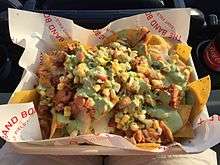
Four permanent concession stands and several portable carts located on the concourse offer traditional ballpark foods including hot dogs, corn dogs, pizza, soft pretzels, ice cream, and popcorn.[13] Each stand also serves foods unique to and common in Nashville and the South, including Nashville hot chicken, pulled pork barbecue sandwiches, and Tennessee chow chow pork chop sandwiches.[68] The stadium's second level has a bar, lounge, and concessions area with views of the field; it is accessible only by those with suite, party-deck, or upper-deck tickets.[67][69]
The Band Box
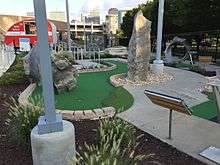
Another specialty concession area is The Band Box, a 4,000 sq ft (370 m2) outdoor restaurant and bar located on the right-center field concourse.[70] The restaurant serves variations on traditional ballpark foods including cheeseburgers, chicken sandwiches, jalapeño corn fritters, smoked chicken nachos, quinoa chopped salads, and local draft craft beer.[70] Its 150-person bar is located on the right field concourse.[13][46][71] The bar has an adjoining lounge area with couches, televisions, ping pong, cornhole, foosball, and shuffleboard, which is open to all game ticket-holders.[49][72] Patrons in the adjacent 4-top seating section can order food and drinks from The Band Box and have items delivered to their seats.[70] On June 28, 2016, a 9-hole miniature golf course, called The Country Club at The Band Box, opened behind the restaurant between the bar and Fifth Avenue North. Each of the nine holes exhibits art from different local or regional artists. It is open to game attendees for an additional $5 playing fee.[73]
Parking
A 1,000-car above-ground parking garage, owned by the state, is located south of the stadium's center field entrance on Harrison Street between Fourth and Fifth Avenues.[74] As the garage is used by state employees during the day, game attendees are only able to use it for evening and weekend games.[75] Other state-owned free parking lots and paid private lots are located in the vicinity.[74] The Metro Transit Authority's Music City Circuit provides bus service to and from a drop-off site at Fifth Avenue North and Harrison Street. Nashville BCycle, the city's bike-share program, has a station at First Tennessee Park.[76]
References
- ↑ "Sounds Woes Continue". Nashville Sounds. Minor League Baseball. July 28, 2015. Archived from the original on 2015-09-11. Retrieved September 11, 2015.
- 1 2 3 4 5 6 7 8 9 10 11 12 13 "Fact Sheet - Highlights of First Tennessee Park Construction Tour". Metropolitan Government of Nashville and Davidson County, Tennessee. February 4, 2015. Retrieved February 11, 2015.
- 1 2 "Sounds Fall to Dodgers in Front of Largest Crowd in Ballpark History". Nashville Sounds. Minor League Baseball. July 3, 2016. Retrieved July 3, 2016.
- 1 2 3 4 "First Tennessee Park" (PDF). 2016 Nashville Sounds Media Guide. Minor League Baseball. 2016. p. 9. Archived from the original (PDF) on June 30, 2016.
- 1 2 "Mayor, Nashville Sounds Celebrate Groundbreaking for New Ballpark". Nashville.gov. Metropolitan Government of Nashville and Davidson County, Tennessee. January 27, 2014. Retrieved April 21, 2015.
- 1 2 3 4 5 6 7 8 9 Reichard, Kevin (April 20, 2015). "First Tennessee Park / Nashville Sounds". Ballpark Digest. August Publications. Retrieved April 20, 2015.
- 1 2 3 4 5 Garrison, Joey (March 18, 2015). "Nashville Sounds Stadium to Cost $10M More Than Expected". The Tennessean. Nashville. Retrieved March 19, 2015.
- ↑ Federal Reserve Bank of Minneapolis Community Development Project. "Consumer Price Index (estimate) 1800–". Federal Reserve Bank of Minneapolis. Retrieved October 21, 2016.
- 1 2 "First Tennessee to Put Name on Proposed Sounds Stadium". Nashville Business Journal. November 21, 2003. Archived from the original on April 21, 2015.
- ↑ "Purcell Firm On City, Sounds Stadium Agreement". WSMV. Nashville. September 11, 2006. Archived from the original on October 21, 2008.
- ↑ "Deadline For Sounds Stadium Proposal Passes". WSMV. Nashville. April 16, 2007. Archived from the original on May 24, 2011.
- ↑ Stults, Rachel (April 11, 2008). "Sounds Cover All the Bases to Ready Ballpark for Opener". The Tennessean. Nashville. p. 1A. Retrieved February 21, 2014.
- 1 2 3 4 5 6 7 8 9 10 11 Ammenheuser, David. "Coming Home to Sulphur Dell". The Tennessean. Retrieved April 16, 2015.
- ↑ "The Nashville Ballpark: Ballpark Site Evaluation Study" (PDF). The Business Journals. Populous. November 2011. Retrieved September 26, 2016.
- 1 2 3 4 5 6 "Fact Sheet - Sulphur Dell Ballpark Proposal". Metropolitan Government of Nashville and Davidson County, Tennessee. November 11, 2013. Retrieved September 26, 2016.
- ↑ Boyer, E. J. (March 23, 2015). "Want to attend the Sounds' First Tennessee Park home opener? It'll cost you". Nashville Business Journal. Retrieved April 22, 2014.
- 1 2 Garrison, Joey (November 19, 2014). "New Sounds Stadium Adds $5M to Price Tag". The Tennessean. Nashville. Retrieved December 5, 2014.
- 1 2 Reichard, Kevin (April 6, 2016). "Ballpark Village Pitched for First Tennessee Park". Ballpark Digest. August Publications. Retrieved November 11, 2016.
- ↑ "Real Estate Notes: Developer Buys Ballpark-area Site for $3.45M". NashvillePost.com. Nashville. September 23, 2014. Retrieved April 21, 2015.
- ↑ Boyer, E. J. (April 22, 2014). "First Tennessee Bank Buys Naming Rights to New Sounds Stadium". Nashville Business Journal. Retrieved April 22, 2014.
- ↑ Hale, Steven (December 4, 2013). "Sounds Ballpark Deal Rounds Second, Headed for Final Vote Next Week". Nashville Scene. Retrieved December 8, 2013.
- 1 2 3 4 5 6 7 8 9 "Baseball Has Come Home". Inside Pitch. 4 (1). Nashville. April 17, 2015. pp. 8–19.
- ↑ McCalvy, Adam (September 17, 2014). "Melvin Irked Over Breakup With Triple-A Affiliate". Milwaukee Brewers. Major League Baseball. Retrieved March 31, 2015.
- ↑ Tamburin, Adam (April 4, 2014). "Nashville Ballpark Build Unearths Ancient Finds". The Tennessean. Nashville. Retrieved March 31, 2015.
- ↑ Barnes, Todd (November 20, 2014). "Tennessee State Museum to House Sulphur Dell Artifacts". The Tennessean. Nashville. Retrieved March 31, 2015.
- ↑ "LEED BD+C: New Construction v3 - LEED 2009: First Tennessee Park". U.S. Green Building Council. April 2015. Retrieved April 14, 2015.
- 1 2 Garrison, Joey (April 14, 2015). "New Sounds Stadium Earns LEED Silver Certification". The Tennessean. Nashville. Retrieved April 14, 2015.
- 1 2 "Cumberland River Greenway: Downtown" (PDF). Greenways For Nashville. 2016. Retrieved November 10, 2016.
- 1 2 3 4 5 6 "Sounds Walk-Off in Home Opener". MILB.com. April 18, 2015. Retrieved April 18, 2015.
- ↑ "Colorado Springs vs. Nashville, April 17, 2015". MILB.com. April 17, 2015. Retrieved April 18, 2015.
- ↑ "Sounds Bested By Dodgers In Series Opener". MILB.com. April 21, 2015. Retrieved April 22, 2015.
- 1 2 Herron, Jennifer (March 30, 2015). "Box Seats Sell out for Opening Night at Sounds' New Stadium". WSMV. Nashville. Archived from the original on April 3, 2015.
- ↑ Ammenheuser, David (July 16, 2015). "Sounds Have Already Bypassed 2014 Attendance Mark". The Tennessean. Nashville. Retrieved August 4, 2015.
- ↑ "Nashville Drops Home Finale". Nashville Sounds. Minor League Baseball. September 3, 2015. Retrieved September 4, 2015.
- ↑ "Sounds Announce Enhanced Fan Safety Measures at First Tennessee Park". Nashville Sounds. Minor League Baseball. January 12, 2016. Retrieved April 8, 2016.
- ↑ "Ballpark – 2016 Preview". Inside Pitch (1). Nashville Sounds. April 2016.
- ↑ "2015 Celebrity Softball Game: Event Info". City of Hope. Retrieved April 3, 2015.
- ↑ West, Kay (June 14, 2015). "It's Team iHeart Over Team Opry in a Walk-off Winning Hit from Bret Michaels". People. Time, Inc. Retrieved November 13, 2015.
- 1 2 3 4 Organ, Mike (October 25, 2015). "Vanderbilt to Play Belmont at First Tennessee Park". The Tennessean. Nashville. Retrieved October 27, 2015.
- ↑ Sparks, Adam (March 29, 2016). "Vanderbilt wins First Tennessee Park's first college game". USA Today. Retrieved March 30, 2016.
- ↑ "The Course". Rock 'n' Roll Nashville Marathon. Retrieved March 25, 2016.
- ↑ "Sounds to Host "Big Guitar Brewfest" on July 16". MILB.com. June 3, 2016. Retrieved June 3, 2016.
- ↑ Nipper, Skip (March 16, 2015). "Nashville Bugs, Builders, and Ballpark Construction". 262 Down Right. Retrieved September 26, 2016.
- 1 2 Nipper, Skip (2007). Baseball in Nashville. Arcadia Publishing. pp. 99–100. ISBN 978-0-7385-4391-8.
- ↑ Nipper, Skip (October 24, 2013). "New Ballpark, New Opening Day, New Memories". 262 Down Right. Retrieved September 26, 2016.
- 1 2 3 4 Boyd, Steve (April 10, 2015). "12 Design Features Not to Miss on First Tennessee Park Opening Day". Populous. Archived from the original on April 17, 2015.
- 1 2 3 Ammenheuser, Dave (March 17, 2015). "12 Facts As First Tennessee Park Opener Nears". The Tennessean. Nashville. Retrieved March 17, 2015.
- ↑ Leonard, Mike (April 20, 2015). "First Tennessee Park: 7 cool Environmental Features". The Tennessean. Nashville. Retrieved April 21, 2015.
- 1 2 3 4 Hill, Benjamin (August 14, 2015). "Take a Tour of Nashville's New Ballpark". MILB.com. Archived from the original on August 14, 2015.
- ↑ Negro League Baseball in Tennessee (Video). YouTube. December 1, 2015. Event occurs at 2:26. Retrieved December 12, 2015.
- ↑ "2016 Nashville Sounds A to Z". The Tennessean. Nashville. April 6, 2016. Retrieved April 6, 2016.
- ↑ "First Tennessee Park Review". Stadium Journey. Archived from the original on October 27, 2015.
- ↑ Ammenheuser, Dave (March 19, 2015). "Sounds' New Stadium Now Has Turf, Home Plate". The Tennessean. Nashville. Retrieved March 19, 2015.
- 1 2 3 "First Tennessee Park" (PDF). 2015 Nashville Sounds Media Guide. Minor League Baseball. 2015. p. 206. Archived from the original (PDF) on April 7, 2015.
- ↑ Behind the Scenes with the Designers of First Tennessee Park (Video). Populous. April 10, 2015. Event occurs at 1:00. Retrieved April 21, 2015.
- ↑ Nipper, Skip (January 4, 2014). "Sulphur Dell: A Brief History". 262 Down Right. Retrieved February 6, 2015.
- 1 2 3 Fox, David (June 18, 2015). "Basics Like Housing and Meals Remain a Challenge for Minor League Players, Even with a Spanking New Stadium". Nashville Scene. Archived from the original on September 11, 2015.
- ↑ "Sounds to Name Umpire Dressing Room After Nashville Native Chuck Meriwether". Nashville Sounds. Minor League Baseball. May 5, 2016. Retrieved May 5, 2016.
- ↑ Dykstra, Sam (October 23, 2015). "Toolshed: Final Triple-A Park Factors Review". MiLB.com. Retrieved October 25, 2015.
- ↑ Dykstra, Sam (November 15, 2016). "Toolshed Stats: Triple-A ballpark factors". MiLB.com. Retrieved November 15, 2016.
- ↑ Cole, Nick (April 22, 2014). "First Tennessee's Name Will Go on New Sounds Ballpark". The Tennessean. Nashville. Retrieved May 5, 2014.
- 1 2 "Sounds to have new guitar scoreboard in new stadium". The Tennessean. Nashville. July 3, 2014. Retrieved September 27, 2016.
- 1 2 3 "Sounds, Mayor Unveil State-of-the-Art Guitar Scoreboard For First Tennessee Park". MILB.com. June 20, 2014. Retrieved June 20, 2014.
- ↑ Jackson, Josh (January 15, 2015). "Triple-A, Double-A to Implement Pitch Clock". MILB.com. Retrieved April 20, 2015.
- 1 2 3 4 "2015 Nashville Sounds Season Ticket Memberships" (PDF). Nashville Sounds. Minor League Baseball. Retrieved February 4, 2015.
- 1 2 "2015 Nashville Sounds Suite Leases and Rentals Memberships" (PDF). Nashville Sounds. Minor League Baseball. Retrieved February 4, 2015.
- 1 2 3 4 5 "2016 Nashville Sounds Group Information" (PDF). Nashville Sounds. Minor League Baseball. Retrieved July 7, 2016.
- ↑ "Centerplate and Nashville Sounds Give Fans More to Cheer About on Menus at the New First Tennessee Park". MarketWatch. April 17, 2015. Archived from the original on April 17, 2015.
- ↑ Hill, Benjamin (October 12, 2015). "On the Road: My First Look at First Tennessee Park in Nashville". MILB.com. Retrieved October 13, 2015.
- 1 2 3 White, Abby (March 30, 2015). "Take Me Out to The Band Box: Strategic Hospitality Partners With Nashville Sounds in New Restaurant". Nashville Scene. Nashville. Archived from the original on April 11, 2015.
- ↑ Hill, Benjamin (October 13, 2015). "On the Road: Gourmet Nachos and Hot Chicken in Nashville". MILB.com. Retrieved October 14, 2015.
- ↑ Wood, Tom (April 25, 2015). "Nashville Sounds Owner, Players Marvel at New Park". The Daily News. Memphis. Archived from the original on September 11, 2015.
- ↑ "Miniature Golf Course Opens at First Tennessee Park". WKRN. June 29, 2016. Retrieved June 29, 2016.
- 1 2 "Parking Information". Nashville Sounds. Minor League Baseball. Retrieved March 29, 2016.
- ↑ Ammenheuser, David (April 6, 2016). "Sounds' Opening Day: 5 Things to Know". The Tennessean. Nashville. Retrieved April 6, 2016.
- ↑ Garrison, Joey (February 27, 2015). "Sounds' Parking Plan Relies On Shuttles, Walking, Transit". The Tennessean. Nashville. Retrieved February 27, 2015.
External links
| Wikimedia Commons has media related to First Tennessee Park. |
- Official website
- Nashville Sounds: First Tennessee Park
- Metro Government of Nashville & Davidson County Sports Authority: First Tennessee Park
- Construction photographs
- The Band Box
